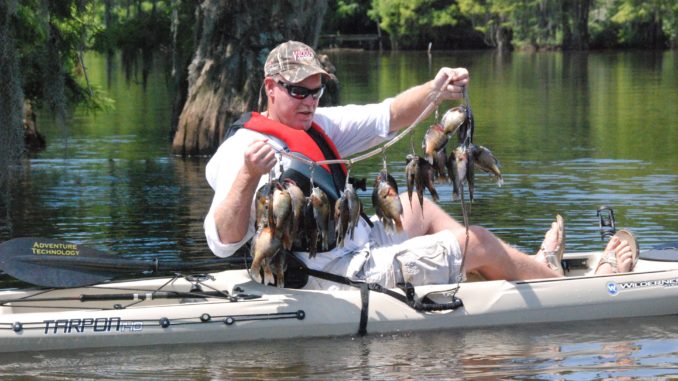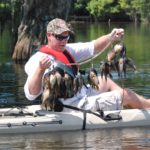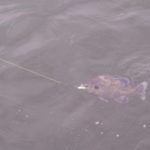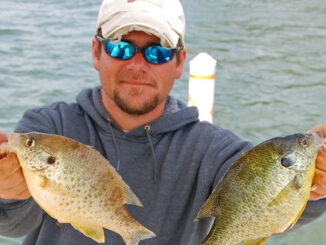
Paddlers have great access to sunfish areas
May is a tough month if you’re just trying to catch one fish species. Both water and air temperatures are pleasantly warm, and most fish are still relatively shallow. It’s a great month to fish for just about everything freshwater or saltwater, but it’s the perfect month to fish for bream. In the Palmetto State, bream typically means bluegills, but it can also mean shellcrackers, warmouths and a variety of sun perch.
Kayaks and canoes provide the ultimate access to spawning bream, which will take their cues around the April 22 and May 21 full moons. Fishing pressure from boating anglers on easy access waters means that every bream bed in a shallow pocket, saddle and back end of a creek will be picked over every couple of days. Use your kayak to get into areas that motors can’t or fear to tread, which means farm ponds, park lakes and swamps are going to be your best bets for finding more and bigger fish.
While depth finders are a necessity when paddling for other species most of the year, you won’t really need one in May. Use your eyes, nose and arms to locate suitable bream beds. In a typical pond or slough, this means slowly paddling or even poling around the upper reaches scouting for the familiar, saucer-shaped indentions in sandy bottoms. You can skip muddy bottoms, as mud makes for unsuitable bedding.
A “fishy” smell can be very discernible when bream are both fanning beds and fertilizing eggs. The odor is sometimes almost palatable. It’s of note that shellcrackers tend to bed earlier than bluegills, but they will use the same general areas, with shellcrackers preferring slighter deeper areas than bluegills.
Fly-rodding for bedding bluegills from a kayak is about as much fun as you can have on the water. A 3-weight fly rod and a handful of popping bugs drives bedding bream nuts. Whether you are standing to cast or sitting, clear your front deck of obstacles as much as possible to allow room to strip out line and cast smoothly without hanging up on rod holders, rigging clips or loose gear.
When targeting bream with live bait, you’ll need two distinctly different rod setups. Bluegills eat mostly insects and feed upward. For this reason you want to target them using live crickets or grasshoppers. A simple but deadly rod for fishing from a kayak is a 9- to 12-foot Breambuster with a single guide and line tie-off. No reel is needed. Rig the rod with a 6- to 7-foot length of monofilament, a hook, a small split-shot and an adjustable, pegged bobber.
The rod can be wielded with one hand, flinging and flipping the cork into every nook and cranny while sculling with a short paddle in the other. When the cork lands in a bream bed, you’ll know it, as is will sink out of sight. Immediately boat the first fish, shove a 6- to 8-foot stakeout pole into one of your boat’s thru-hull scupper holes to maintain position and work the area thoroughly from your staked position.
Fishing for shellcrackers and warmouth bream, sometimes called rock bass, requires a different approach. You can anchor your kayak or drift on the top of a sandy saddle or long point and use a 5- or 6-foot ultralight spinning rod to work the bottom with a split-shot rig and a No. 2, light-wire hook. Bait the hook with either a half or whole night crawler and fan-cast the area. Whichever direction yields a bite or fish warrants more casts.
For artificial-bait enthusiasts, a small inline or safety pin-type spinnerbait, small crankbait or jig can be cast with a spinning rod into prospective areas. Typical baits for this type of presentation include Roostertails, Beetle Spins and Rebel’s line of miniature crankbaits, which can be as deadly as popping bugs when cast on light line with ultralight spinning tackle.
Few anglers specifically target bream in rivers. South Carolina has a myriad of wide, slow-moving rivers that are home to some spectacular redbreast fishing in the lower part of the state, shellcrackers and bluegills in the Midland areas, and more bluegills with warmouth mixed in the Upstate.
A pair of transport vehicles can be used to mark put-in and take-out points while two or more paddlers float a section of river. Panfish rarely hold in areas of fast-moving water but may be just on the outside edges of eddies and shoals. For spawning fish in rivers, be sure to target any tributary that dumps into the main river as well as any dead-end sloughs or cuts that offer 4- to 6-foot depths out of the main current.
Because bream beds in rivers may not be obvious, fan-casting as much fishy looking water as possible while drifting with the current using a 1/16-ounce Road Runner jighead is a great search tactic. Plastics will work on the jighead, but any type of hair attached to the jig is doubly dangerous for panfish.






